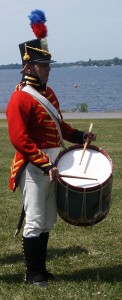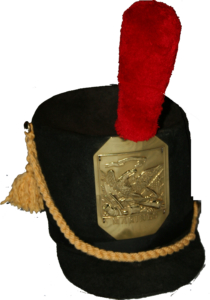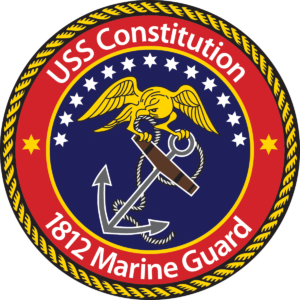SUPPLY AND DEMAND
The “military industrial complex” in 1812 was centered around Philadelphia. Philadelphia was close to the center of the United States’ population and a central location in regards to the American military in the early years of the republic. For these reasons the Government sought out contractors for clothing and supplies in the Philadelphia region more than any other major population center. This being the case, the Marine Barracks in Philadelphia became the supply depot of the Marine Corps and the commander of the barracks, Major Anthony Gale, working with the Quartermaster and Commandant in Washington, became the primary distributor of clothing and equipment for the Marine Corps during this era. By and large this would remain true for the entire war but as the numbers of Marines grew and the British blockade of the US coast tightened it became necessary for equipment and uniforms to be purchased and made in other cities and this led to some instances of uniform and equipment differences amongst the Marines. The greatest challenge of the supply system was transporting gear to the more remote stations that had no or little supporting industry such as Sackets Harbor, Put-in-Bay on Lake Erie and, most difficult of all due to the British blockade, New Orleans. There are many officers’ letters that state that, even though it is the middle of January, they are still awaiting winter clothing. Ship guards also had a tough time keeping the men supplied. The sporadic and usually unannounced arrival into ports often found that the nearest Marine Barracks lacked the uniforms and equipment for the barracks guard never mind that needed by arriving ships. The worst case of this was on board the USS Enterprise upon its arrival in Portsmouth NH in Mid-1813. The sergeant in command of the guard’s letter to Commandant Wharton stated that the Marines were owed two years worth of clothing and more than a years’ worth of pay.
Even though there were difficulties the overall performance of the supply system of the Marine Corps was pretty well run under the given circumstances. The Commandant, the Quartermasters, the Quartermaster Sergeant and Major Anthony Gale performed admirably and with the best intentions and concern for the Marines themselves.
FORMAL UNIFORM ORDER of 1810:
H’d Quarters of the Marine Corps
Washington April 19th, 1810
The following dress will be the uniform of the Marine Corps.
Officers- Navy blue coat, buttoned across the breast, with two rows of Navy buttons, right on each side, the button-holes laced, & brot to a point in the center thus , Three buttons on the sleeves laced in the same manner, the pockets with three buttons plac’d & with lace similar to the sleeves; the collar of scarlet, with two buttons on each side laced; laced cuffs scarlet, the skirts turn’d up with scarlet & two laced Diamonds on blue ground on each thus, the lapels of the coat lin’d with scarlet & three button-holes laced on each side, this however not to be seen when on duty in Winter. Vest & pantaloons white: Cock’t Hat, or shapeau-bras, with gold lace-loop, & navy button under the cockade, the cockade of leather thus described, the Hat to be worn over the right eye, the range of the cock of the Hat of course over the left eye, with Gold Tassels from the sides. Scarlet plumes; the hair queued and powder’d. The officers when in full uniform, are to wear a scarlet sash round the waist, outside the coat and over the belt, tied on the left side& over the thigh. Black boots to the knee, with black silk Tassels. Black leather stock when on Duty.
The Officer Grades are to be determined in the following manner vis.
A Colonel- Two Gold Epauletts, one on each shoulder
A Major- Two Gold Epauletts, one on each shoulder
A Captain- A Gold Epaulett on the right shoulder & Gold counter-strap on the left
A First Lieut.- A Gold epaulett on the right shoulder. A Second Lieut.- A gold Epaulett on the left shoulder
The Staff to wear- A Gold Epaulett, & Counter-strap embroidered on blue Cloth.
Side Arms-Yellow-mounted Sabres, with Gilt scabbards, & white cross belts with Gilt plates.
The Uniform of Marines
To be a coatee single breasted, one row of buttons, yellow worsted binding on each side, the extreme ends of which represent a half Diamond thus , white cloth pantaloons, with black cloth Gaiters to the knee. Linen overalls in the Summer, high crown’d Caps, without a brim, & a plume of red plush on its front, with a brass eagle and plate. Hat-band of yellow cord, with a Tassel of the same colour. Sergeants to wear leather cockades on the left side of the Hat, with scarlet plume.
Quartermaster of the Marine Corps Circular:
QM office HQ M. Corps Washn Oct 20 1813
I have been directed by the Lt. Col. Commanding to state to you the quantity of clothing which in the future will be allowed to each Marine during his five years’ enlistment.
The reduction, which is made in some articles, of which neither the comfort or appearance of the soldier requires one in each year, is made up to him in his fatigue suit, which adds to his comfort and enables him to preserve his uniform. This, I am informed, is not a new regulation but an old one much neglected.
Clothing for 5 years
I have the honor to be respectfully your obt servt
S. Bacon[1]
[1] Records of The Quartermaster’s Department 1813-1942, RG 127.5, National Archives and Record Administration, Washington D. C.
UNIFORM, ENLISTED:
The Marines of 1812 were among the best dressed forces the United States fielded at the time. They were the ambassadors of American arms that would be seen all over the world as they traveled aboard the ships of the U.S. Navy. When performing any military duty Marines were to wear a single breasted, Federal Blue, wool coat with scarlet cuffs, turn backs and collar. On the turn backs were a yellow, worsted wool tape diamond. On the front of the coat there were eight buttons of the 1797 U.S. Navy design, sometimes called the “common navy button”. From the button holes angled rows of yellow, worsted wool tape, ending in a “half diamond” created a “V” like pattern. On the sleeves there are three similar pieces of yellow, worsted wool tape starting at the top of the cuff and extending out from three buttons. Likewise, on the tails of the coat that hang on the hips, there is the same pattern of worsted wool tape extending from three buttons. On the collar there are two buttons with the worsted wool tape projecting forward towards the opening of the collar. Also on the collar is a small button with the same naval pattern that receives the epaulette. The epaulette is also lined with the yellow worsted wool tape and when fastened it holds the accoutrement belts in place on a Marine’s shoulder. Only the sleeves and the tails are lined and in the lining of the tail there are pockets.
The Marine wore a tall, yeoman pattern felt cap trimmed with a yellow cord and tassels, brass cap plate, a brass eagle “in place of a cockade” and a red plush plume. The visor is 2.5 inches long and stiffened by an added piece of leather.
A Marine’s hair was required to be in a queue (pronounce simply as “Q”) which they were required to have on and powdered at all times on duty under arms. If a Marine did not have long enough hair to put into a queue he was required to purchase a false queue himself. Under the coat the Marine wore a linen or cotton long sleeved shirt with ruffles on the neck line. On the neck the Marine wore a 2.5 inch leather stock with a brass clasping system. In the Summer Marines wore white, linen, high wasted, narrow fall front trousers that fit snuggly on the legs but had room in the seat to allow movement. In the winter, assuming the supply chain was working properly, the linen trousers were replaced by white, woolen overalls. In both summer and winter uniform Marines wore knee high, black wool gaiters that were fastened with fifteen small naval buttons.
Perhaps the most well known part of the uniform of the Marines of the 1812 Era was the neck stock often pointed out as the reason Marines are called “leathernecks,” but these were not unique to the Marine Corps. Most soldiers and Marines of all countries of the era wore these devices. The neck stock is a 2.5 in. wide black leather band that fit around the neck of the Marine and was fasten with a copper clasping system.
US Marine neck stock
The traditional or mythical reason for these neck stocks that has been passed down was that they were worn to protect the wearer’s neck from sword, knife and bayonet blades. While this makes a great story it is not accurate. The true intent of these were to keep the men’s head erect and straight, preventing them from paying too much attention to the action (carnage) all about them and to help them maintain a military posture. Though we will continue to hear the traditional explanation for the neck stock we can now also share the true reason.
Rounding out the uniform was the black, mid height, leather, and straight last military shoe of the period.
UNIFORM, NCO
For the NCO, like the Music, much of the uniform is the same as the enlisted man. The cut, color scheme and material of the coat are the exact same for the corporals. The difference is that the corporal wears a yellow shoulder knot, or epaulette, on the right shoulder. The other difference for the corporal is the substitution of a red feather plume for the plush plume which is worn on the cap in the same location of the enlisted man’s plush plume.
Sergeants have the same color scheme as the enlisted man’s coat but historically their uniforms were made of finer materials. The sergeant will also wear yellow shoulder knots, or epaulettes, on both shoulders. The sergeant’s cap will have a red feather plume but will be worn over the left ear with an accompanying black leather cockade.
To date there are no extant Marine Corps documents from the period that show the Marine sergeants of the 1812 era wore a sash. Evidence shows that they were worn before the major uniform change in 1804 and in periods later than 1826.
UNIFORM, MUSIC

The uniform worn by United States Marine Corps musics (the name/rank given to drummers, fifers and Marine Band members), was of the same style and cut as the enlisted men‘s with the same tape and buttons upon the coat, but it was in “reverse colors.” Where the enlisted man‘s coat is blue the music‘s is red and vice versa. This red coat lives today with the President’s Own United States Marine Band as well as the USMC Drum and Bugle Corps.
Other than the reverse colors of the music coat the only other difference in the uniform was the plume on the music’s cap. It differed in its placement, its color and its material. The music’s plume was to be a tall feather plume of red and blue feathers and was placed over the left ear.
UNIFORM, FATIGUE, ENLISTED:
When not on military duty the Marines would wear a fatigue uniform. The fatigue uniform, both jacket and trousers, were usually made of wool. These wool fatigue uniforms came in whatever color was most available and affordable; Mixed Gray or Navy Blue. For a cover in fatigues Marines were issued a very unique and quite advanced piece of equipment, a black leather, folding cap that could be worn three different ways depending upon the weather. The cap had a crown with large fore and aft flaps that stood up with a small brim in the front. On the fore flap, when worn up and observer would see four brass letters; “U S M C” and under those a number between 1 and 1044. It is not quite sure what the numbers suggest, but the Marine corps was authorized the 1044 men at the beginning of the War of 1812. There is a theory that these numbers may represent the first use of “serial” numbers by U.S. armed forces. By mid-1813 the fatigue caps were being ordered without letter or numbers. In bad weather the aft flap could be put down to cove the Marine’s neck. In really bad weather the cap could be turned sideways and both flaps could be drawn over the sides of the head like the famous fisherman Sou’ Wester. The cap’s functions and its storage due to its folding quality made it very useful and desirable.






